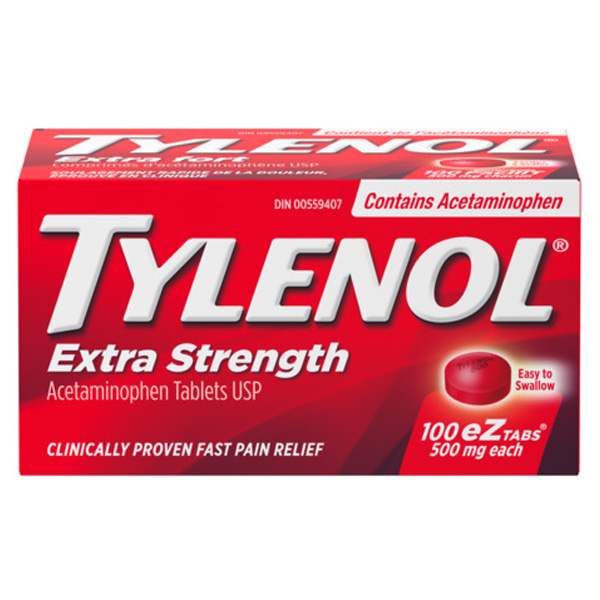NSAIDs: The Basics
Non-Steroidal Anti-Inflammatory Drugs, or NSAIDs, are medications that are commonly used to reduce pain and inflammation.
You are likely familiar with common NSAIDs like Advil, Aspirin and Naproxen, and have used them when fighting an illness or recovering from an injury.
NSAIDs work by blocking inflammation in the body to help you recover, feel better, and get back to the activities you love.

The risk of experiencing side effects from using NSAIDs is very low and therefore they are often recommended as a first line treatment for illness, injuries to bone, muscle and connective tissue (musculoskeletal), arthritis, and lower back pain.
Types of NSAIDs
NSAIDs come in two forms.
Either they are consumed as pills (orally) or rubbed onto the skin as a cream (topically).
Common oral NSAIDs include:
Non-prescription / Over-the-counter
- Advil (ibuprofen)
- Aleve (naproxen)
- Aspirin
Prescription strength
- Celebrex (celecoxib)
- Indocin (Indomethacin)
- Meclofenamate
- Motrin (ibuprofen)
- Nalfon (fenoprofen)
- Piroxicam
- Toradol (Ketorolac)
- Voltaren (diclofenac)
Common topical NSAIDs include:
- Pennsaid (diclofenac)
- Voltaren (diclofenac)
Some important things to know about NSAIDs is that they…
- Can be taken as pills or applied as a cream
- Block inflammation signals in the body and reduce pain
- Allow for faster healing and recovery
- Have a very low risk of side effects
- Treat pain like Tylenol, but Tylenol does not reduce inflammation
- Help manage:
- Illness
- Lower back pain
- MSK injuries
- Arthritis
- Offer a much better alternative for treating pain compared to opioids (due to side effects and risk of addiction)
How NSAIDs work
When you are injured or ill, inflammation is your body’s first response.
Signals are sent within the body that result in inflammation, leading to the classic symptoms of redness, swelling and pain.
These symptoms can be experienced at the location of an injury e.g., a painful sprained ankle, or across the body e.g., experiencing a fever when you have the flu.
NSAIDS work in the body by blocking these inflammation signals to reduce pain and symptoms of inflammation. While inflammation is important to healing, it can be excessive and cause prolonged symptoms.
Side Effects of NSAIDs
There is a very low risk you will experience side effects from taking NSAIDs. While these medications are specifically designed to relieve pain and prevent inflammation, it is possible for NSAIDs to affect the normal functions of your body. They can alter some of the normal and healthy processes in the gastrointestinal tract, heart and kidneys.
Though the risk of these side effects is very low, the risk does increase after 1-2 weeks of use. Therefore, use of NSAIDs should be kept to a short term. Furthermore, if you suffer from any pre-existing gastrointestinal, heart or kidney conditions, you should consult with a physician before taking NSAIDs.
What about Tylenol?

Tylenol (acetaminophen) is not considered an NSAID.
Though it is a common pain relief medication and often used interchangeably with Advil, it works differently than NSAIDs in the body. After consumption, acetaminophen travels to the brain where it prevents pain signals.
It is also different from NSAIDs because it does not decrease inflammation. Therefore, Tylenol is a great pain relieving (analgesic) drug but doesn’t offer the anti-inflammatory benefit of NSAIDs.
What are NSAIDs typically used for?
Illness
If you are suffering from viral infections like a cold, the flu, or COVID-19, NSAIDs can be part of your management strategy. By reducing the body’s inflammatory response, they decrease fever and pain while your body fights the infection, making the symptoms of sickness more manageable. Recent evidence has even suggested that NSAIDs can prevent some of the processes that the COVID-19 and influenza A viruses use to cause infection, thereby reducing the length of illness further.
Bacterial infections are much different than viral infections and are treated using antibiotics. The effects of NSAIDs on bacteria are not well understood and we do not know of any benefit in combating bacterial illness. NSAIDs can, however, still offer pain relief if needed.
Lower back pain
Lower back pain is a difficult chronic condition that can affect your lifestyle and wellbeing in many ways. The most recent research suggests that NSAIDs can offer a moderate improvement in pain and function.

Musculoskeletal injuries
If you are experiencing a musculoskeletal injury (injury to a bone, joint, tendon or ligament), NSAIDs are a good option. Medical experts advise their use for the anti-inflammatory and pain-reducing effects for conditions such as tendon and ligament injuries, fractures, muscular injuries, and other musculoskeletal injuries.
You might be concerned about the anti-inflammatories effects of NSAIDs for the recovery of your musculoskeletal injuries. In recent years, research has suggested that inflammation is critical to the proper healing of damaged tissue and that the use of NSAIDs may ultimately prolong recovery. However, these claims have been primarily supported by laboratory experiments in mice but have NOT been supported by research in humans.
Research in humans shows that NSAIDs decrease your pain and lower inflammation and as long as they are used short term (< 1-2 weeks), and are unlikely to cause side effects. Furthermore, the pain relief experienced from NSAIDs allows for increased mobility and function of injuries which is critical to healing and recovery. Ultimately, NSAIDs are a great option for your pain management and recovery from a musculoskeletal injury.
Arthritis
A common chronic musculoskeletal condition you might be experiencing is osteoarthritis (OA).
OA is a degenerative disease in which the cartilage, bone and ligaments that support joints, is broken down over time. The inflammation that results progresses the disease faster and causes joint pain. Both topical (cream) and oral (pill) NSAIDs, are extremely effective for OA as they block inflammation while providing pain relief. For this to happen, however, they must be used long term, and thus come with an increased risk of side effects.
How to choose an NSAID
When choosing which NSAID is best for you, it is important to consider your illness, injury, and any pre-existing health conditions.
Advil (Ibuprofen) poses the lowest risk of side effects and is available at most pharmacies and groceries stores. Other NSAIDs may work better for specific illnesses or injuries, and you should consult a physician to learn if one may be the best option for you.
To target a specific area of pain, NSAIDs in cream form are highly effective. They can improve pain symptoms at the site of injury and because they are only applied to one area of the body, there is a lower risk of side effects.
Finally, if you suffer from certain pre-existing heart, gastrointestinal or kidney conditions, then NSAIDs may not be recommended. You should consult a physician to ensure that NSAIDs are safe for you.
Overall, NSAIDs do not fully treat or cure any illness, injury or pain. However, their effects can make all of these conditions much more manageable, allowing you to get back to your normal life and enjoy the activities you love.
Contributing Expert

Sam Hendry, University of British Columbia MD Program
References
Abdel Shaheed C, Beardsley J, Day RO, McLachlan AJ. Immunomodulatory effects of pharmaceutical opioids and antipyretic analgesics: Mechanisms and relevance to infection. Br J Clin Pharmacol. 2022; 88(7): 3114-3131. doi:10.1111/bcp.15281
Baroncini A, Maffulli N, Al-Zyoud H, Bell A, Sevic A, Migliorini F. Nonopioid pharmacological management of acute low back pain: a level I of evidence systematic review. J Orthop Res. 2023; 41: 1781-1791. doi:10.1002/jor.25508
Borgeat A, et al. The effect of nonsteroidal anti-inflammatory drugs on bone healing in humans: A qualitative, systematic review. J Clin Anesth. 2018 Sep;49:92-100. doi: 10.1016/j.jclinane.2018.06.020. Epub 2018 Jun 15. PMID: 29913395.
Busse JW, et al. Management of Acute Pain From Non-Low Back, Musculoskeletal Injuries : A Systematic Review and Network Meta-analysis of Randomized Trials. Ann Intern Med. 2020 Nov 3;173(9):730-738. doi: 10.7326/M19-3601. Epub 2020 Aug 18. PMID: 32805127.
Cashin AG, et al. Pharmacological treatments for low back pain in adults: an overview of Cochrane Reviews. Cochrane Database of Systematic Reviews 2023, Issue 4. Art. No.: CD013815. DOI: 10.1002/14651858.CD013815.pub2.
Cashman JN. The mechanisms of action of NSAIDs in analgesia. Drugs. 1996;52 Suppl 5:13-23. doi: 10.2165/00003495-199600525-00004. PMID: 8922554.
Choi, M et al. Managing postoperative pain in adult outpatients: a systematic review and meta-analysis comparing codeine with NSAIDs. CMAJ Jun 2021, 193 (24) E895-E905; DOI: 10.1503/cmaj.201915
Coxib and traditional NSAID Trialists’ (CNT) Collaboration. Vascular and upper gastrointestinal effects of non-steroidal anti-inflammatory drugs: meta-analyses of individual participant data from randomised trials. Lancet. 2013 Aug 31;382(9894):769-79. doi: 10.1016/S0140-6736(13)60900-9. Epub 2013 May 30. PMID: 23726390; PMCID: PMC3778977.
Ellen M.E. Sykes, Dawn White, Sydney McLaughlin, and Ayush Kumar. 2024. Salicylic acids and pathogenic bacteria: new perspectives on an old compound. Canadian Journal of Microbiology. 70(1): 1-14. https://doi.org/10.1139/cjm-2023-0123
Foletto VS, da Rosa TF, Serafin MB, Bottega A, Hörner R. Repositioning of non-antibiotic drugs as an alternative to microbial resistance: a systematic review. Int J Antimicrob Agents. 2021 Sep;58(3):106380. doi: 10.1016/j.ijantimicag.2021.106380. Epub 2021 Jun 22. PMID: 34166776.
Hansen JM, Hallas J, Lauritsen JM, Bytzer P. Non-steroidal anti-inflammatory drugs and ulcer complications: a risk factor analysis for clinical decision-making. Scand J Gastroenterol. 1996 Feb;31(2):126-30. doi: 10.3109/00365529609031975. PMID: 8658033
Hung CW, Riggan ND, Hunt TR 3rd, Halawi MJ. What’s Important: A Rallying Call for Nonsteroidal Anti-Inflammatory Drugs in Musculoskeletal Pain: Improving Value of Care While Combating the Opioid Epidemic. J Bone Joint Surg Am. 2022 Apr 6;104(7):659-663. doi: 10.2106/JBJS.21.00466. Epub 2021 Aug 26. PMID: 34437306.
Jóźwiak-Bebenista M, Nowak JZ. Paracetamol: mechanism of action, applications and safety concern. Acta Pol Pharm. 2014 Jan-Feb;71(1):11-23. PMID: 24779190.
Magni A, et al. Management of Osteoarthritis: Expert Opinion on NSAIDs. Pain Ther. 2021 Dec;10(2):783-808. doi: 10.1007/s40122-021-00260-1. Epub 2021 Apr 19. PMID: 33876393; PMCID: PMC8586433.
Manoukian, M.A.C., Migdal, C.W., Tembhekar, A.R. et al. Topical Administration of Ibuprofen for Injured Athletes: Considerations, Formulations, and Comparison to Oral Delivery. Sports Med – Open 3, 36 (2017). https://doi.org/10.1186/s40798-017-0103-2
Marcianò, G., Muraca, L., Rania, V. and Gallelli, L. (2023), Ibuprofen in the Management of Viral Infections: The Lesson of COVID-19 for Its Use in a Clinical Setting. J Clin Pharm, 63: 975-992. https://doi.org/10.1002/jcph.2258
Moore N. Coronary Risks Associated with Diclofenac and Other NSAIDs: An Update. Drug Saf. 2020 Apr;43(4):301-318. doi: 10.1007/s40264-019-00900-8. PMID: 31916080.
Murphy PB, Kasotakis G, Haut ER, et al Efficacy and safety of non-steroidal anti-inflammatory drugs (NSAIDs) for the treatment of acute pain after orthopedic trauma: a practice management guideline from the Eastern Association for the Surgery of Trauma and the Orthopedic Trauma Association. Trauma Surgery & Acute Care Open 2023;8:e001056. doi: 10.1136/tsaco-2022-001056
Tarus B, Bertrand H, Zedda G, Di Primo C, Quideau S, Slama-Schwok A. Structure-based design of novel naproxen derivatives targeting monomeric nucleoprotein of Influenza A virus. J Biomol Struct Dyn. 2015 Sep;33(9):1899-912. doi: 10.1080/07391102.2014.979230.
Terrier O, et al. Antiviral Properties of the NSAID Drug Naproxen Targeting the Nucleoprotein of SARS-CoV-2 Coronavirus. Molecules. 2021 Apr 29;26(9):2593. doi: 10.3390/molecules26092593. PMID: 33946802; PMCID: PMC8124269.
Tong, L., Yu, H., Huang, X. et al. Current understanding of osteoarthritis pathogenesis and relevant new approaches. Bone Res 10, 60 (2022). https://doi.org/10.1038/s41413-022-00226-9
Wolfarth, B., Speed, C., Raymuev, K., Vanden Bossche, L., & Migliore, A. (2022). Managing pain and inflammation associated with musculoskeletal disease: time for a change? Current Medical Research and Opinion, 38(10), 1695–1701. https://doi.org/10.1080/03007995.2022.2108618
Zheng W, et al. Naproxen Exhibits Broad Anti-influenza Virus Activity in Mice by Impeding Viral Nucleoprotein Nuclear Export. Cell Rep. 2019 May 7;27(6):1875-1885.e5. doi: 10.1016/j.celrep.2019.04.053. PMID: 31067470.







